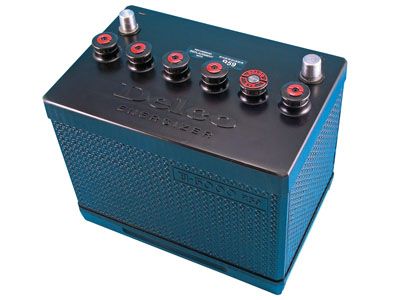
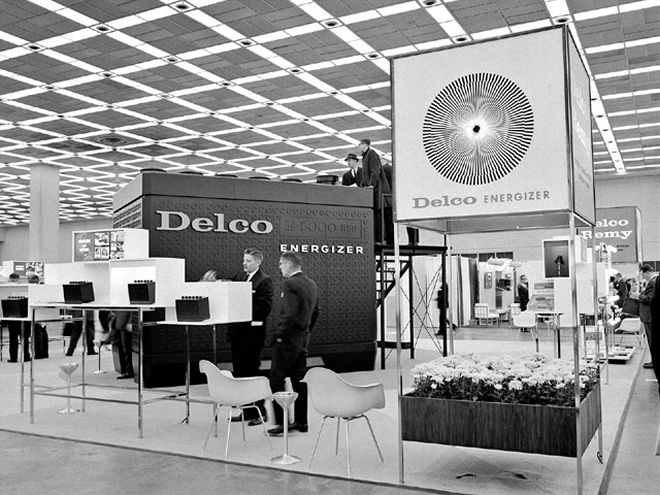
Last month in "Battery Boot Camp," HPP brought you a guide to the Delco-Remy tar-top batteries that powered Pontiacs from 1955 through 1966. While Delco-Remy was pleased with the speed with which it was able to market the 12V battery, the tar-top design was expensive to produce and maintain, and was inherently prone to an extremely short product life. Although there were technological advances in the engineering of the battery-primarily in the design of the internal separators-it became clear by the mid-'60s that the tar-top design itself needed to be retired.
In 1966, Delco-Remy changed the automotive world forever with the introduction of the Energizer hard-top battery. According to Delco-Remy, "The unique Energizer design, with its through-the-partition cell connectors, replaces six conventional cell covers, ten bushings, and five external connectors. Fewer parts and simplified assembly methods combine to produce a more reliable unit than is possible with conventional construction techniques. Energizer production is a carefully controlled, highly automated process. Continuous flow processing and specially controlled atmospheric conditions, as required, are maintained from raw materials to the shipping carton."
Introduced in the GTO and 2+2 in 1966, by '67, the Energizer was standard equipment on every Pontiac. Most HPP readers instantly recognize it when they see it in a classic GTO or Firebird. Delco described it as "a new concept in packaged electrical energy for automotive vehicles. The visible newness starts with the modern 'sheer look' case and continues right to the top of the smooth, easy-to-clean, one-piece cover with its ever-watchful electrolyte level indicator-the 'Delco Eye.'"
In 1970, R79 Delco sealed-terminal batteries began replacing the R59 top-posts on the factory's 455-equipped Pontiacs. According to AC Delco, the change to a sealed-terminal was critical for customer satisfaction. "Self-locking terminals stay maintenance-free and tight...side location helps guard against corrosion because electrolyte [deposits] and road splash are less likely to collect around terminals. Clean, tightly-sealed cable connections keep full power available to your electrical system. Gradual loss of cranking performance due to corroding terminals is eliminated," Delco-Remy said.
Follow along as we look at the hard-top batteries that Delco-Remy made famous in Pontiacs from 1966-1975.
HPP thanks John Sawruk for his research and assistance in making this article possible, Rocky Rotella for his research and Pontiac literature, and Restoration Battery for providing its expertise and products for photographs.
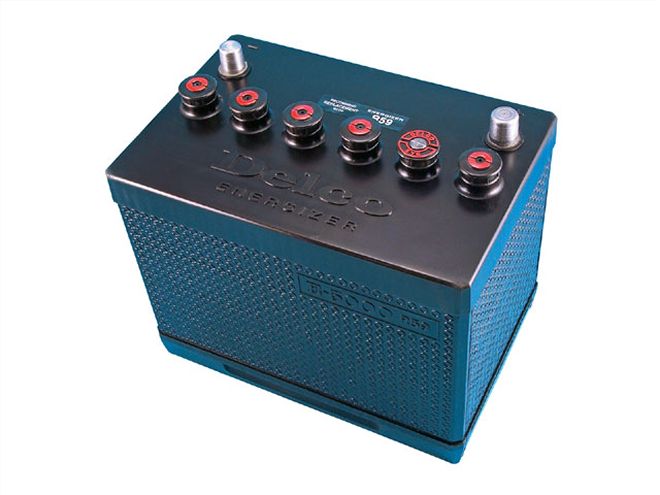
Delco-Remy R59 Energizer
Delco-Remy began installing the one-piece, hard-top cover Energizer battery in the 2+2 and the GTO in 1966. The R59 Energizer was completely redesigned on the inside. The hard-rubber separators were replaced with polyvinyl chloride separators. Delco stated, "Polyvinyl chloride separators will resist oxidization, chipping, tearing, and the effects of vibration much longer than ordinary paper-based or hard-rubber separators and give the Energizer longer cranking in cold weather."
Energizer batteries also used through-the-partition connectors. Each battery had five partitions, or walls, dividing the six cells. The cells must be connected to each other. (Remember, previously in the tar-top batteries, the cells were connected to each other by straps that went over the partitions.) The cells were now connected by through-the-partition connectors. This created a shorter, more efficient electrical path between the cells and minimized internal electrical resistance up to 60 percent.
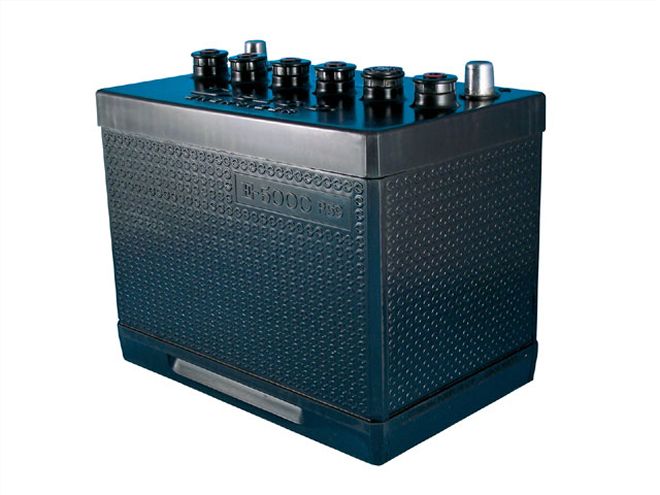
R59 Energizer batteries were the same size as the Group 24 tar-top batteries, but with a modernized look. With the new R59 Energizer batteries, Delco replaced the stippling on the sides with its trademark-a grid of Delco half-circles that resembled a broken circle. The R59 Energizer batteries had push-in instead of screw-in vent caps. Five of the six vent caps were black with the two half-circles painted in red. The sixth vent cap was a Delco Eye, with those words painted in red. This cap had a clear plastic center that extended into the battery electrolytes (acid) and was designed to allow a battery owner to look down into the battery and, with maintenance, keep it at the correct fluid level. If the "eye" was dark, the battery had the correct level of fluid; when it was clear, distilled water was needed. (Remember, electrolytes (acid) are only added to a new battery-use distilled water only after use.) Also unique for the R59 was Delco-Remy's first use of a decal.
Physical Features
Model No. E5000 R59 • GM Part No. 1980030 • 1966-1972
The R59S is a heavy-duty version of the R59 that was offered under various RPO codes. It features 3,250 watts of cranking power at 0 degrees.
Delco-Remy R79/R79S/R89/r89S Energizer
In 1969, Delco-Remy introduced the Group 74 side-terminal battery. Its dimensions are 10.25 inches long, 7 inches wide, and 8.75 inches high (to the top cover). Because of its concern that owners wouldn't be able to tell the "sealed-post" positive terminal from the negative, Delco-Remy installed a 5/16-inch thread into the negative terminal and a 3/8-inch thread into the positive terminal so they couldn't be reversed. It's unknown exactly when this "safety" thread feature was discontinued, but most likely by the '71 model year. Today, all reproduction versions of the R89S and R89W batteries feature 3/8-inch thread on both the positive and negative terminals.
The R79S was offered for one year only-1970-and was superseded by the R89S. R79, R79S, and R89 batteries aren't currently reproduced. R79S batteries were installed in '70 Pontiacs with the 455 engine and the R89S was used in '71-'72 Pontiacs with the 455, and in many Pontiac V-8 applications from '73 to '75. The R89S is a hard-top battery, too, very similar in appearance to the R59, except for its side terminals. The R89S case was also constructed of hard rubber, with polyvinyl chloride separators and the cells were connected through the partitions. The R89S still used the five Delco half-circle vent caps and the Delco Eye.
Physical Features
Model E5000 R89S • GM Part No. 1980147 • 1971-1975
Delco-Remy R89W Energizer
A heavy-duty version of the R89-series battery was called the R89W and was ordered with RPO code T60 (1971-1973) or UA1 (1974-1975).
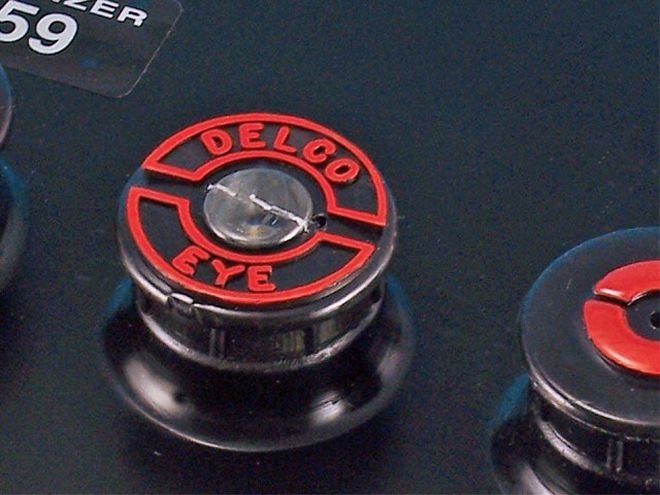
This was the introduction of Delco-Remy's first polypropylene (plastic) case. By 1977, all Delco assembly-line contract batteries were constructed with them. The biggest advantage was that the case walls and the partition were much thinner, allowing an even larger increase in active plate materials and, accordingly, a much higher battery cranking power. Weight was an additional advantage of the polypropylene case. The R89S (hard-rubber case) weighs 34 pounds, holds four quarts of acid, has 13 plates per cell and has 420 cold cranking amps (CCA) at 0 degrees. In comparison, the R89W (polypropylene case) weighs only 32 pounds, holds 4.8 quarts of acid, has 15 plates per cell and has 465 CCA at 0 degrees.
The R89W has a distinctive appearance, and was very different in cosmetics from previous Delco Energizer batteries. Its entire top cover and case surface are wrinkled, resembling elephant skin. The R89W still uses the five Delco half-circle vent caps and the Delco Eye vent cap. The case has vertical lines (they're actually small indentations) spaced approximately 1.5 inches apart on all four sides.
Physical Features
Model E5000 R89W • GM Part No. 1980150 • 1971-1975 (Heavy-Duty)
Other Batteries Of The ERA
From 1973-1975, Delco-Remy also produced a Y87 side-terminal battery for the six-cylinder Firebird and LeMans. It measured 9.125 inches long, 7 inches wide, and 8.75 inches tall, and is categorized as a Group 72 battery. It offered 310 CCA power at 0 degrees.
Another Delco-Remy battery is the C89, Pontiac's very first maintenance-free battery, which is listed in factory literature as a Group 74, sealed-case, side-terminal battery. It featured 3,750 watts of cranking power at 0 degrees, 80 amp hours and was the standard battery for the '71 SJ 455.
Factory literature also mentions: Y54, R58 side-terminal (ST), R58S, Y58, Y86, R87 (ST), R87P (ST), R87PA (ST), R88 (ST), R88S (ST), R88W (ST) R88X (ST), Y88 (ST), R89SP (ST), R89WP (ST) R89X (ST) and the Y89 (ST) batteries. Each of these variants carry the same size dimensions as its family group number-for example, all batteries with an "89" in their model number are Group 74 batteries. There are probably more variant model numbers for different years/models that we weren't able to identify. None of these batteries are currently reproduced.
Conclusion
In this guide, we've attempted to list all versions of the contract batteries installed into Pontiacs from the factory during the '55-'75 period. However, anomalies are bound to exist. When using this guide against your original owner's manual, it's best to understand the owner's manual lists the preferred replacement battery for your vehicle at the time of its printing. Many owner's and service manuals received revised printings throughout the model year, so it is possible that two or more replacement batteries are recommended by the factory for your Pontiac.
If for some reason your battery was replaced when the car was new, there's a strong likelihood that its service replacement battery wasn't the same model number as what was installed at the factory. There may also be typographical errors within factory manuals. Please see the sidebar by Pontiac Historian John Sawruk on how the hobby addresses these concerns when judging your Pontiac at a national event.
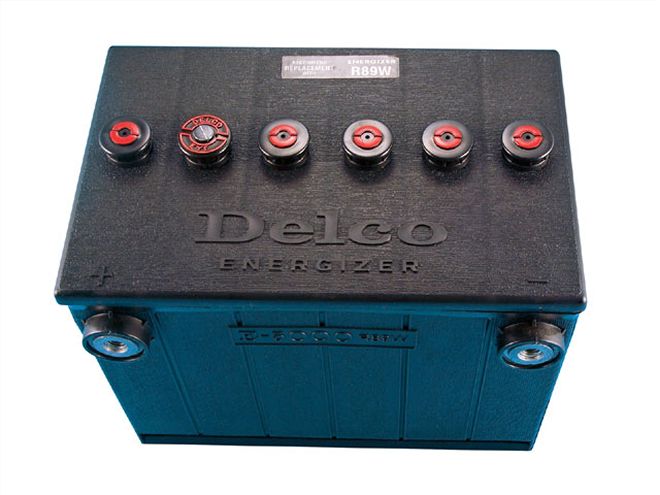
What Happened With The Delco X Maintenance-Free Battery?
Thanks to the research of John Sawruk and Rocky Rotella, we were able to determine that in model year '71, Delco Remy introduced the Delco X maintenance-free battery, the C89, which was standard equipment only on the Grand Prix SJ, and as option 654 for Firebirds, LeMans, Catalina, Bonneville, and Grand Ville. Though it remained standard on the SJ, the option for other Pontiacs was cancelled twice due to limited availability; first in February 1971, returning as option 691 in June 1971, then cancelled again in October 1971. For the '73 model year, it returned in most model lines. It's not currently being reproduced.
Frequently Asked Battery Questions
Q: What is a hard-top battery?
A: A hard-top battery uses one piece of molded plastic to seal its face-top. It was introduced in '66 for the GTO and 2+2.
Q: What is a "maintenance-free" battery?
A: A maintenance-free battery was delivered "wet" from Delco-Remy with calcium lead, and required no addition of distilled water to maintain charging capacity.
Q: How did Delco define a heavy-duty battery?
A: R-Series batteries came with 2,900 watts of cranking power at 0 degrees. If the letter "S" was added to the end of the model number-i.e. R59S, R79S, or R89S-the battery came with 3,250 watts of cranking power at 0 degrees and was called "heavy-duty." If the letter "W" was added to the end of the model number-i.e. R79W or R89W-the battery came with 3,750 watts of cranking power at 0 degrees, and was still called "heavy-duty."
Q: Why did my original battery have charcoal-colored caps?
A: In 1973, Delco-Remy changed to a charcoal colored "flame resistor" cap upon the mandate of the DOT. Even today, reproduction batteries use charcoal inside the period-correct caps to adhere to DOT requirements.
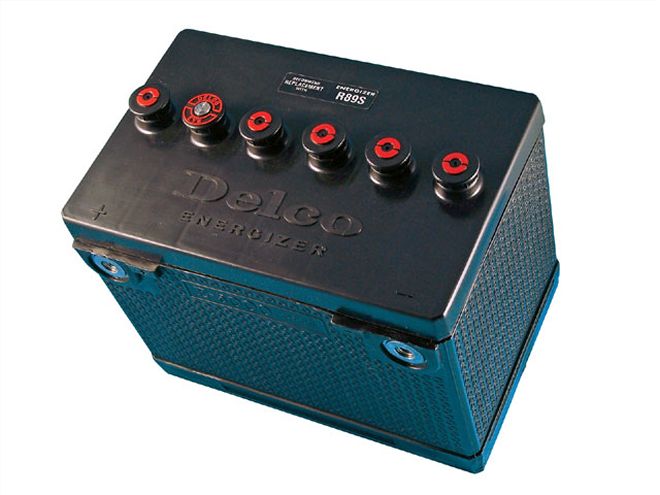
Q: Why does my maintenance-free reproduction battery still have caps?
A: Reproduction batteries maintain the identical outward appearance of the original lead-acid batteries manufactured by Delco-Remy and maintenance-free internal components. Adding acid or water to a reproduction maintenance-free battery will ruin it.
Q: Why does my counter battery have a different color painted on it than other similar batteries I've seen?
A: Remy produced three versions of each series of counter battery in most model years. The entry-level battery was painted green (i.e. E1000 G59) and was designed for "popular applications having moderate starting and electrical power demands," according to a 1971 Delco product guide. The standard battery was painted yellow (i.e. E3000 Y59) and provided "high capacity for normal cranking power requirements." The top-of-the-line battery was painted red (i.e. E5000 R59) and started your car "fast with an instant power-burst of up to 2,900 watts of cranking power."
Got Battery?
Maybe not! One of the problems for collectors is that not all the varieties of Delco batteries have been reproduced, such as the original '71 pre-Freedom Maintenance-Free C89. This situation extends even to modern cars. In our personal experience with the Delco Freedom OEM heavy-duty battery option, the life ranges from 7-14 years.
Even modern batteries have changed style and colors over the years. For example, our original '84 Sunbird Turbo has had multiple Delco batteries in its life and the current one doesn't look like its original. (More about modern ones later.)
I commend HPP for taking on this very difficult and confusing subject. Sometimes there were midyear changes that weren't well documented. Owner's manuals may or may not be helpful, depending on the year. Some literature lists GM part numbers, while others use Delco terms, such as the R59. Service replacements may not have been the same battery as OEM, which further confuses things. (This is true even today.)
There appear to be typos in some owner's manuals. Some list even-numbered batteries, which were OEM, and not available for service. Some don't seem to properly identify side-terminal batteries. (Various apparent mistakes were found in the '71-'75 owner's manuals-another example of why you can't always trust factory literature, or photos, for that matter.) Also be aware that the suffix "S," like in R59S, doesn't mean "side-terminal"-some people think it does.
I believe there's a misperception regarding reproduction battery life. Our classic cars sit much more than our daily drivers, so the battery charge needs to be maintained by another method. Smarter battery chargers fit that bill. I heard about the Battery Tender 12V DC output at 1.25 amps from my son, and I've been using it for battery tending ever since with outstanding results and fewer battery changes.
Let's talk about judging. I've always felt that one of the easiest places to gain or lose points is the battery. (I also feel that an original-type battery enhances a stock, popular-vote car). In POCI points judging, you can lose up to five points for the battery.
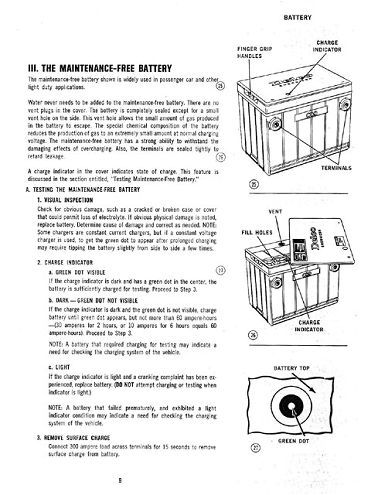
Take my '71 1/2 GT-37 for example. I had the heavy-duty battery option, R59S. It isn't reproduced (maybe some vendor should reproduce the R59S top label), so I have an R59-the closest you can get. If the same car had a 350 two-barrel, the standard battery was a Y59 (yellow paint on the top caps versus red on the R59), but it's not reproduced, either. The best you can get is an R59.
As a member of both the GTOAA and POCI Judging Committees, I encourage the judges to award full points on restored cars since the owners have done the best they can. "Original" cars can go the same route, or a modern Delco-Remy equivalent replacement to the original battery can be used.
What about modern cars? I'm starting to regret turning in some of our used batteries as cores. They could've been saved to show the correct exterior appearance for future reproduction purposes. (Yes, people will collect "modern" cars in the future and some of the following comments apply to Firebirds, for example). Some modern Pontiacs, such as the Vibe, came with batteries labeled as Delphi, not AC-Delco, which is apparently related to the spin-off by GM of its parts operations. These batteries appear similar, however.
Do you remember that the original "Freedom" Maintenance-Free batteries had blue tops, white cases, and multi-colored top decals that included red? (I hope my memory is right on this). The battery top also had two "penthouses" and an eye.
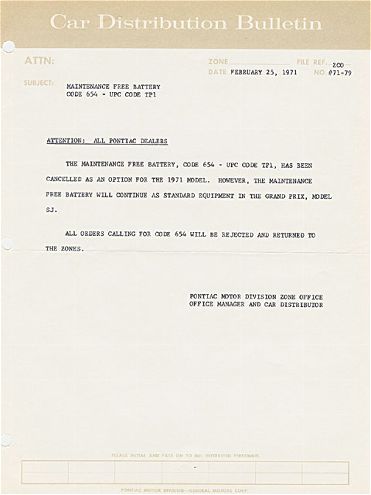
At some point, the top color changed to black and the decal colors also changed. I believe the OEM battery cases stayed white and the service cases were eventually black, as well. The OEM battery number and the replacement battery number, which were different from each other, were on the decals on top of the case at some point. Eventually, the "penthouses" disappeared and the top of the cases became "flat." Then the "eye" was eliminated.
Recently, the top style changed again on the newer AC-Delco batteries. I believe the AC-Delco Professional most closely resembles the original "Freedom" style, except the cases are now all black. This may be the best modern car owners can do.
Dealers only stock a certain number of batteries, and if you need a warranty replacement, it looks like you get one with equal or greater CCA than your original, which may not look the same.
I want to briefly talk about CCA-at 0 degrees F, specifically-and reserve capacity. CCA gives some idea of how powerful the battery is. Higher CCA batteries are better, tend to last longer, and are usually heavier. Some people have hot cranking problems with their traditional Pontiac V-8s due to too little CCA (455s are the worst).
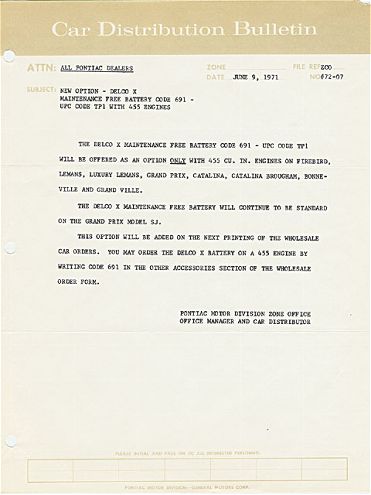
Reserve capacity gives you some idea of how long the battery will last (in minutes) if the charging system dies. However, there are sometimes other reasons for specifying a high-reserve capacity. For example, the '84 Sunbird Turbo had a high-reserve capacity battery. One of its devices could turn the electric cooling fan on after the engine was shut off. This was to help control the underhood temperatures. Of course, this electric motor was a major draw on the battery at a time when it wasn't being charged.
By the way, 4-cylinders are harder to start cold than 8-cylinders. Why? Ask me when you see me.
Well, by now the author of this article and editor of the magazine are probably sorry that they asked me to write a sidebar, so I'll stop here. - John Sawruk, P.E.